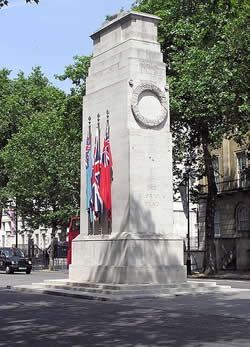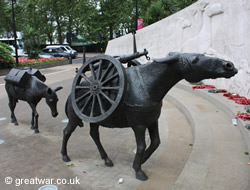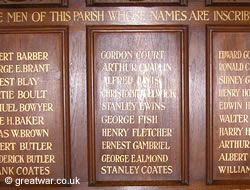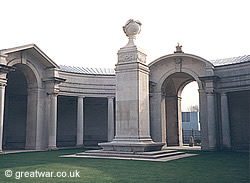WW1 Monuments and Memorials in the United Kingdom
In the United Kingdom the scale of the loss of those serving with the military during the Great War resulted in the fact that there are very few towns or villages which do not have some sort of public memorial to commemorate their men and women who died in the First World War. In some cases the memorials also commemorate those people who served and returned from the war.
During the years following the 1914-1918 war public monuments were put up with public funding or by private and public subscription. In many cases a Roll of Honour was inscribed with the names of the fallen, both civilians and military personnel, in churches, public buildings, factories, railway stations, collieries, schools and so on.
- A National Memorial: The Cenotaph
- Thankful Villages
- Animals in War Memorial
- National Memorial Arboretum, Staffordshire
- UK War Memorials Archive
- War Memorials Trust
A National Memorial: The Cenotaph

|
The Cenotaph in Whitehall, central London, is the national War Memorial for the United Kingdom which originated as a memorial to the British losses in the 1914-1918 war.
Originally made from wood and plaster it was designed by Sir Edwin Lutyens as a temporary cenotaph for a national Peace Day Celebration and the Peace Parade held in London on 19th July 1919. The origin of the word cenotaph is taken from the Greek words kenos meaning “empty” and taphos meaning “tomb”. During the Peace Parade on its route through Wihitehall thousands of troops marched past this temporary Cenotaph, turned their eyes to it in respect as they passed and the commanding officers saluted it. Following the parade members of the public placed flowers there and the structure quickly became a focal point of national grief for all those many thousands of people who had lost loved ones in the war.
The decision to build a permanent structure in place of the wooden one was made. It was also agreed to keep it in the same location as the temporary one in Whitehall which had become such a special focus of the Peace Parade. Lutyen's solemn and dignified design was built in Portland Stone from December 1919 and was finished in time for a parade to pass by it on 11th November 1920 to mark the interrment of the British “Unknown Warrior” at Westminster Abbey. The Cenotaph was again the focus of a ceremony of Remembrance on the anniversary of the Armistice on 11th November 1921. Subsequently it became the location for the United Kingdom's national annual national ceremony of Remembrance each November.
Thankful Villages
Some places in England saw their young men go off to war, and unusually, given the scale of the tragedy and loss of so many thousands of lives throughout the United Kingdom, all the men from that locality did return safely. These such places became known as “Thankful Villages”, a term coined by the writer and journalist Arthur Mee (1875-1943). There are 52 civil parishes in England and Wales known to have all their men returned. There are was not one “Thankful Village” in Scotland or Ireland (part of the United Kingdom at that time) where all the serving men returned.
Of the 52 “Thankful Villages” 14 of them became known as “Doubly Thankful Villages”, because all their men serving in the Second World War also returned home.
Some public war memorials, therefore, do not necessarily commemorate those who died in the Great War, but they commemorate those from the locality who served and who did return.
A comprehensive article about “Thankful Villages” has been compiled for the excellent website www.hellfirecorner.co.uk by reknowned WW1 researchers Norman Thorpe, Rod Morris and Tom Morgan. To read this article, which includes a list of the 52 Thankful Villages go to:
Website: www.hellfirecorner.co.uk Thankful
Animals in War Memorial

|
Many thousands of animals served with the military during the First World War both on the battlefields and behind the lines in support. In addition to the horses employed by the mounted military units, horses, mules, donkeys were requisitioned and taken into the theatres of war to carry ammunition, pull guns and wagons. Some 8 million horses, mules and donkeys died in the First World War while serving with the British and Dominion Forces. When horsepower was limited due to shortages of horses and mules, oxen were used to pull guns and wagons. Dogs were used to patrol, to seek out wounded men, search for bombs or mines, they carried medical equipment and messages. Thousands of pigeons were used to carry messages. Canaries were used by the military tunnelers. In the Middle Eastern theatres of war camels were used by the military.
A monument to the role played by animals in war and the sacrifice that so many thousands of them made is to be found in central London at Brook Gate, Park Lane.
Visit the website for photographs and information about the Animals in War Memorial in central London:
Website: www.animalsinwar.org.uk
National Memorial Arboretum, Staffordshire

|
The National Memorial Arboretum is located in the heart of England. It is a living memorial of trees and plants dedicated to the concept of Remembrance. Over recent years the number of visitors to this special place has grown. Memorials are many and varied including the Armed Forces Memorial, monuments to military units and associations, the police, fire brigade and ambulance services, civilian societies, charities, associations and individuals.
National Memorial Arboretum, Staffordshire
UK War Memorials Archive

|
In a Channel 4 history documentary series called “The Lost Generation” viewers were invited to help the programme makers to set up a database for all the WW1 memorials in the United Kingdom. The series resulted in a partnership between Channel 4 and the Imperial War Museum in London, whereby the United Kingdom Inventory of War Memorials was esblished. The project has now been taken over by the Imperial War Museum and the museum is compiling the list of over 60,000 memorials. Volunteers around the UK are assisting with this work. A database list of all those commemorated on these memorials is also being compiled.
As a result of the work being carried out on the inventory a wide variety of memorials have been recorded including many private ones ranging from a plaque in a church to an individual to a large Roll of Honour signboard commemorating groups of colleagues from the same company, sports team or school. During the cataloguing process some previously unknown WW1 memorials have been discovered hidden from view and thankfully some have even been rescued from rubbish tips.
For information about the UKNIWM and for a link to the website see our page at:
War Memorials Trust

|
The War Memorials Trust is a charity working to preserve and care for over 100,000 war memorials located across the United Kingdom.
To find out about how you can help support the charity as a volunteer or donor, how to get involved with renovation projects and the education resources available to schools, youth groups and students, see the website at:
Website: www.warmemorials.org
Related Topics
War Memorials on the Western Front Battlefields
See our page about memorials and monuments on the Western Front battlefields in Belgium and France. The page provides links to listings, photographs and locations for visitors to the various battlefield sectors:
War Memorials on the Western Front Battlefields
Acknowledgements
Photograph of The Cenotaph courtesy of Arpingstone and Wikimedia Commons at http://en.wikipedia.org/wiki/File:Portland.stone.cenotaph.london.arp.jpg.

